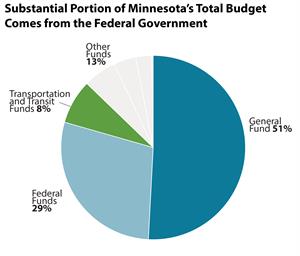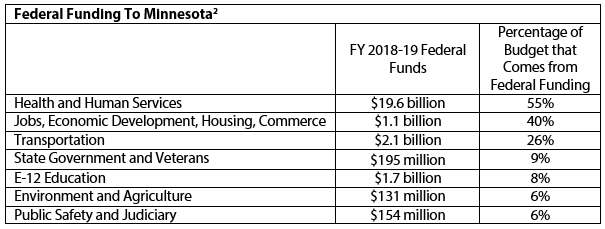
Our state government has traditionally worked in partnership with the federal government to expand opportunity in our state. The federal government is a significant source of funding for Minnesota and helps more Minnesotans have affordable health care, assists low-income families who are trying to make ends meet, and strengthens our roads and transit systems.
In the FY 2018-19 biennium, about 30 percent of the state’s budget comes from the federal government, or close to $25 billion.[1] Additional federal dollars go to local governments and nonprofits for education, transportation, and other community investments.
However, recent federal proposals would slash these supports for states and communities, stepping back from what has long been a strong and crucial partnership.

Federal Funds Support Affordable Health Care in Minnesota
Federal funding is an especially vital funding source for affordable health care. Minnesota’s largest health care programs – Medical Assistance and MinnesotaCare, through which about 1 in 5 Minnesotans receive health care – are financed through partnership with the federal government.[3] In this biennium, nearly $20 billion, or over half, of Minnesota’s Health and Human Services budget is supported by federal funds.[4]
The single largest source of federal revenue to the state is for Medicaid, known in Minnesota as Medical Assistance. This money primarily goes to health care providers to cover the costs of health care for low- and moderate-income people. The federal government distributes Medicaid funding to the states as a match for state spending, and generally covers half of Minnesota’s costs.
Medicaid is currently structured to respond to changes in the economy and in health care. When Medicaid enrollment or the cost of health care go up, federal revenue to the state increases to reflect those changes. This means that Medical Assistance is well poised to meet the needs of Minnesotans when times get tough. For example, when a recession hits and more folks are out of work or have jobs without health insurance, Medical Assistance is there for them.
The federal government also offers states flexibility in how they use their Medicaid dollars through waivers. For example, through Minnesota’s Home and Community Based Services waiver, the state creates alternatives to nursing facilities, and instead Minnesotans with disabilities can receive services that enable them to live in and enjoy their homes and communities.
In addition, Minnesota receives federal Children’s Health Insurance Program (CHIP) funds to cover health care costs for low- and moderate-income children, and pay for prenatal care for pregnant mothers.
MinnesotaCare, Minnesota’s affordable health insurance for more than 89,000 working Minnesotans who don’t have affordable insurance through their employers, is also supported by federal funding.[5] As part of the Affordable Care Act, federal funding primarily funds this essential source of health care.
Minnesotans of All Ages and Backgrounds Count on Federal Funding in Times of Need
Minnesota’s partnership with the federal government extends across the budget, from transportation and economic development to education and additional supports for folks trying to make ends meet.
Minnesotans of all ages receive education funded in part by the federal government. In the FY 2018-19 biennium, the state is expected to receive $1.7 billion in federal funding for E-12 Education. Among other things, this helps fund Adult Basic Education, special education, and early childhood education. Federal dollars also pay for school breakfast and lunch so kids can focus on their classes instead of a grumbling stomach. Thanks in part to the federal government, Minnesota learners have access to the technology, the teachers, and the hearty meals they need to reach their full potential.
Our state’s roads, sidewalks, and transit lines also depend on federal support. Minnesota receives $2.1 billion in FY 2018-19 for highways, safe routes for children to walk to school, and better transit infrastructure for Minnesotans traveling without cars. Federal funding represents over one-quarter of the state’s total spending on transportation.
The federal government also contributes to economic development. In FY 2018-19 about $1.1 billion in federal funding goes to employment and economic development, housing, and commerce in Minnesota.[6] This ranges from the Community Development Program, which supports housing, local infrastructure, and rural communities; to the Contamination Cleanup Grant Program, which keeps communities and our environment safer. It also includes funding for shelters for Minnesotans experiencing homelessness.
Minnesota also receives funding to support vital, basic resources for families who have fallen on hard times through Temporary Assistance for Needy Families (TANF), also known as the Minnesota Family Investment Program (MFIP). TANF federal funds require a state investment, and federal and Minnesota state governments work together to support families. This means that over 20,000 very low-income families receive a small cash benefit each month, and parents work with an employment counselor to find and maintain employment.[7] Some also receive access to child care so that they can go to work, school, or look for work, knowing their kids have stable, nurturing care.
In addition, children across Minnesota have access to affordable child care through the Child Care and Development Block Grant (CCDBG), which provides about $91 million in Federal FY 2017 to the state for the Child Care Assistance Program.[8] Child care can be one of the largest expenses that families with children face, but thanks to federal funding, kids from across the state have more affordable, dependable care so they can thrive. That means parents can get to work or school, and employers throughout Minnesota can find and keep the workers they need. Federal funding also supports thousands of children being placed with foster families.
Another critical partnership is the Supplemental Nutrition Assistance Program (SNAP), formerly known as Food Stamps. While the dollars that are used by Minnesotans to buy food do not flow through the state budget, the state's Department of Human Services administers SNAP, which includes eligibility determinations and enrollment. Close to 500,000 Minnesotans a year can put food on the table thanks to SNAP.[9]
Federal Funding Threats Means our Communities are Threatened
Recently, federal policymakers have proposed to fundamentally weaken federal-state partnerships. President Donald Trump has proposed to cut non-defense discretionary spending – about a third of which goes to states and local governments, and funds key priorities like education, affordable housing, and training and employment services. Meanwhile, Medicaid has faced repeated threats from both the president and Congress that would turn it into a block grant or other ways of capping funding at inadequate levels. These proposals would cut federal funding to the states and shift additional responsibilities to them under the guise of “increasing flexibility.”
But here's the hard truth: states cannot be flexible when they're struggling to scrape together the dollars to fund essential services. Our state policymakers and community members are looking to fortify Minnesota's successes in building broader prosperity, which includes having one of the highest rates of health insurance in the country, and more folks able to make ends meet than many of our neighboring states. But building on our successes can only be done in partnership with the federal government.